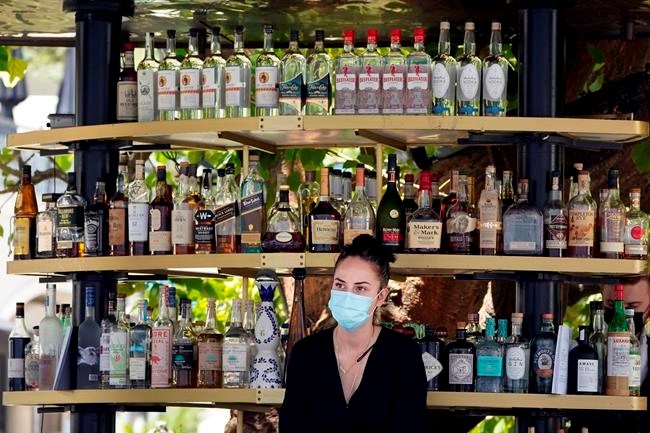SACRAMENTO, Calif. (AP) — Conflicted California workplace regulators approved controversial rules Thursday night that allow workers to go maskless only if every employee in a room is fully vaccinated against the coronavirus.
But the California Occupational Safety and Health Standards Board made clear that the regulations are only a stopgap while they consider further easing pandemic rules in coming weeks or months. The new rules are expected to take effect June 15, the same day the state more broadly loosens masking and other precautions in social settings.
The board initially voted 4-to-3 to reject any changes to current rules.
But chairman David Thomas said that would have left employers with existing regulations, which require masks for all employees, along with social distancing and partitions between employees in certain circumstances.
Moments later, the seven-member board unanimously adopted the revised regulations while a three-member subcommittee considers more changes.
“It’s better than the previous one, because that’s what we’re going back to” if the board didn’t act, Thomas said. “We don’t want to leave the last one in place when this is better than that.”
The off-again, on-again decisions came after major business groups and dozens of individuals spent hours urging the board to further lift pandemic regulations.
“We have to create reasonable and enforceable standards," said board member Nola Kennedy, an initial no vote. "I just don’t think this proposal is there yet.”
Kate Crawford also was initially opposed, saying the revision should more closely follow recent guidelines from the U.S. Centers for Disease Control and Prevention. The guidance says fully vaccinated people can now skip face coverings and distancing in nearly all situations and the state is set to follow that recommendation on June 15.
For some members who initially rejected the revision, the deal-killer was a requirement that employers stockpile the most effective N95 facemasks for employees who want them starting July 1.
They reflected criticism by numerous employer groups who said the requirement will be impractical, expensive and tie up millions of masks that are needed by health care workers.
“Logistically I’m just unclear how a business determines how many, how much,” said Chris Laszcz-Davis, a management representative on the board who initially voted to reject the revised regulations. ”I’m not sure how much we’re buying by recommending N95s. Why not a surgical mask?”
But the initial rejection was not a clear split between labor and management representatives on the board, which also includes public members and safety experts.
The board plans to regroup at its June 17 meeting, but further revising the rules will be a lengthier process. The newly-appointed three-member subcommittee will try to craft acceptable revisions that then must be drafted by Cal/OSHA employees before a public review.
Without a further revision, the revised rules could remain in place into early next year even though coronavirus cases have fallen dramatically in the state after a severe winter spike and as more people get vaccinated.
The workplace rules contrast with the state’s plan to fully reopen in less than two weeks and do away with virtually all mask and social distancing requirements for vaccinated people.
Some opponents suggested that Gov. Gavin Newsom could use his emergency powers to further lift restrictions in the meantime.
More than three-dozen agribusiness opponents said in a comment letter before the vote that the revised rules would put Newsom “in the awkward position of needing to issue an executive order to correct recent actions taken by a Newsom Administration state agency.”
Other critics said lawsuits are certain to challenge the regulations.
Newsom, a Democrat, faces a likely recall election this fall largely driven by frustration over restrictions he ordered during the pandemic. He has made the state’s general June 15 reopening a cornerstone of his response.
He was noncommittal before the vote but noted that Cal/OSHA must apply its rules to a wide variety of businesses, including places like meatpacking facilities that were hit especially hard by the virus.
The Cal/OSHA regulations apply in almost every workplace in the state, including workers in offices, factories and retail. Its pandemic rules apply to all employees except those working from home or where there is a single employee who does not have contact with other people.
“Cal/OSHA is out of step with the rest of the country,” Andrew Sommer said on behalf of the California Employers COVID-19 Prevention Coalition before the vote.
The workplace rules set up “an inconsistent standard” between members of the public and employees of private and government workplaces, the California Chamber of Commerce and more than five dozen other business organizations said in a letter to the board.
For instance, restaurant servers will have to remain masked while working but could go unmasked if they dine at the same location during their off hours, said Katie Hansen, senior legislative director for the California Restaurant Association.
Safety board staff member Eric Berg said the revised rules recognize key differences between employees and the public at large, including that employees have “longer cumulative exposures” in the workplace than with casual social contact.
The revised rules were supported by worker advocates and unions including those representing teamsters, machinists, utility workers, engineers, nurses and other health care workers, and school employees.
“The workplace is not the same as deciding to go to a dinner party or the gym or go to a movie,” said Maggie Robbins, occupational health specialist with Worksafe Inc., an Oakland-based worker advocacy group. “There’s a lot of work to be done before we have a substantially immune population where we can relax more of the controls.”
____
Associated Press writer Olga R. Rodriguez contributed from San Francisco.
Don Thompson, The Associated Press



